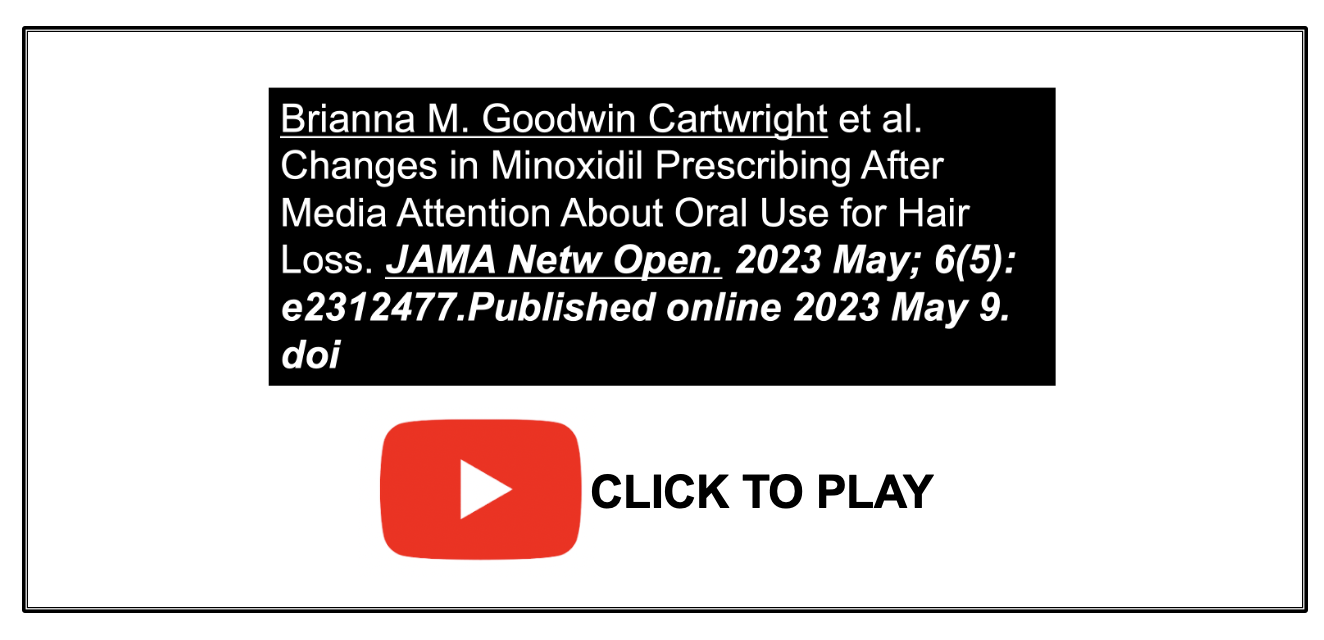What Effect did the New York Times Oral Minoxidil Article have on Oral Minoxidil Prescribing ?
New Study Shows that a New York Times Article on Oral Minoxidil Prompted a Doubling of Oral Minoxidil First Time Prescriptions
Please see prior article related to this article
Goodwin Cartwright BM et al 2023
Authors from the US set out to investigate the rates of new prescriptions of low-dose oral minoxidil after of publication of the New York Times August 18, 2022 article on oral minoxidil.
They used a database known as the Truveta database to search for prescribing information. Truveta holds electronic health records from patients treated in 8 health systems who primarily resided in 13 states. The authors used the databased to search for “first-time” oral minoxidil prescription before (January to July 2022) or after (August to December 2022) publication of the NYT Article. The authors then calculated the weekly rate of first-time oral minoxidil prescriptions for 2.5-mg and 5-mg tablets.
Results
There were 6541 patients with first-time oral minoxidil prescriptions during the study period. 2846 individuals received prescriptions in the 7 months before the NYT Article and 3695 individuals received prescriptions in the 5 months after publication.
The weekly rate of first-time minoxidil prescriptions per 10, 000 outpatient encounters was significantly higher 8 weeks after vs 8 weeks before article publication overall.
Oral minoxidil prescribing patterns in a US healthcare database (Truveta). Figure from: Goodwin Cartwright BM et al. Changes in Minoxidil Prescribing After Media Attention About Oral Use for Hair Loss. JAMA Netw Open. 2023 May; 6(5): e2312477.Published online 2023 May 9. doi. used with creative commons license)
Overall, the rate was 0.9 prescriptions after the article [95% CI, 0.8-1.0 prescriptions] compared 0.5 prescriptions before the article [95% CI, 0.4-0.6 prescriptions]; P < .001).
For males specifically, the rate was 1.1 prescriptions after the article [95% CI, 0.9-1.3 prescriptions] compared to 0.5 prescriptions before the article [95% CI, 0.4-0.6 prescriptions]P < .001). This represents a 2.4 fold increase.
For females, the rate was 0.8 prescriptions after the article [95% CI, 0.7-0.9 prescriptions] compared to 0.5 prescriptions before the article [95% CI, 0.4-0.6 prescriptions] P < .001). This represents a 1.7 fold increase.
The authors noted that after the initial spike in prescriptions associated with article publication, prescriptions decreased overall and for males and females. However, prescription rates were still 50 % above pre-publication rates - as noted in the figure above.
As a type of control, the authors point out that they did not observe similar increases in first-time finasteride or hypertension prescriptions.
CONCLUSON
This was an interesting study. It’s clear that media coverage of health-related news is powerful and may be associated with changes in clinician practices and patient behaviours. It appears that interest in oral minoxidil has increased after the NY Article and prescriptions have increased too.
The authors in this article state that prescribing patterns were not sustained.
I think that this data here shows that the prescribing was still way above normal at the end of the observation period. Even though there was a tremendous spike in prescribing right after the article, prescribing is still 50 % of the prior “pre article” prescribing levels.
With the google trends data showing that interest in oral minoxidil is still on the rise, I think we can’t assume that 5 months is long enough to study the effects on the public.
It takes some time for our patients to process this information or to see the effects of the medication on friends and family before making an appointment to see the doctor to possibly get a prescription. Similarly, it even takes doctors time to start prescribing oral minoxidil to a few patients before they get confident in prescribing to more and more patients.
I think the effect of the NYT article on prescribing patterns is likely much more sustained than authors suggest in the article. At least in my experience, there has been no real waning of interest. In fact, more and more patients, especially more and more older aged patients are now asking about this medication in recent months.
REFERENCE
Goodwin Cartwright BM et al. Changes in Minoxidil Prescribing After Media Attention About Oral Use for Hair Loss. JAMA Netw Open. 2023 May; 6(5): e2312477.Published online 2023 May 9. doi
Kolata G. An Old Medicine Grows New Hair for Pennies a Day, Doctors Say. August 18, 2022. https://www.nytimes.com/2022/08/18/health/minoxidil-hair-loss-pills.html
This article was written by Dr. Jeff Donovan, a Canadian and US board certified dermatologist specializing exclusively in hair loss.




